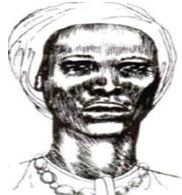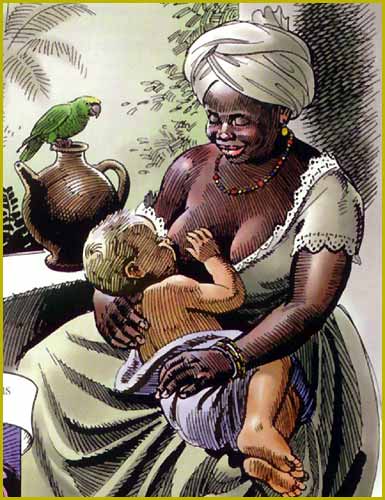 Coming from a tribal African family (Ashan or Akan), Nanny was native from African West Coast (Ghana)/ She belongs to the Jamaican history of colonization from 1680 to 1730. It is told that she arrived in Jamaica as a free woman, bringing her slaves with her. Black slaves brought in Jamaica were coming from Madagascar, Congo, Golden Coast (Guinea Gulf).
Coming from a tribal African family (Ashan or Akan), Nanny was native from African West Coast (Ghana)/ She belongs to the Jamaican history of colonization from 1680 to 1730. It is told that she arrived in Jamaica as a free woman, bringing her slaves with her. Black slaves brought in Jamaica were coming from Madagascar, Congo, Golden Coast (Guinea Gulf).
The Coromantie (or Koromantee) people detained the power on the island and were considered as resistant warriors, brave and audacious, who fought for their rights and freedom, refusing slavery. Rebellions from 1655 to 1830 were commanded by the Afro-Jamaican communities who lived on the island and who resisted the British oppression, using African spirituality, military strategy and children education. Women’s involvement was important because many of them worked in farms and factories.
One of their domestic tasks was the owners’ children education. Union and wedding between slaves was forbidden by the lords, newborns were sold as slaves, women were physically exploited, victims of sexual abuses and rapes. In Afro-Jamaican communities, women were responsible for agricultural production while men were in charge of hunting wild pigs.
At the time, farms constantly suffered from rebels’ attacks, whose goal was to provide themselves with food and to save slaves. With desire for taking revenge, women often took part to those attacks, with machetes, they cut British heads. Marroons communities were influenced by a certain africanism in their structure. Respect and pride symbolized the Black warrior nation, with an important place for feminism.

Queen Nanny played a main part as leader of one of the most important trick of war in Jamaica. She was an example in the struggle against factories’ bosses. Her military successes echoed all over the island. The battles she planned and set up were very efficient. For the British, Nanny was a savage woman, who knew how to plan ambushes and to train her army in camouflage techniques, covering the soldiers with leaves and branches.
During their attacks, British soldiers, surrounded, collapsed on the ground. The soldiers lived in high mountains, in camps or Quilombos. Access to main entrances was difficult. Thanks to the height of the mountains, they were able to observe the ennemy and get close to British camps.
The technique consisted in letting them approach and to counter-attack in single file. It was efficient and many enemies died while only several Marrons passed away. Nanny was the only one who managed to gather Marroons warrior in such extent, in whole Jamaica. She preserved the Black culture thanks to her knowledge about the island. Nowadays, past is a source of pride for Jamaicans and Marroons. Jamaica’s history has survived thanks to the pitiless queen who set up a guerrilla against slavery.
The determination and identification of Black people were political and mystical values, which have been at the centre of the construction and defence of African civilization in Jamaica, against British domination. That struggle which lasted for 80 years doesn’t have any equivalent until today.




